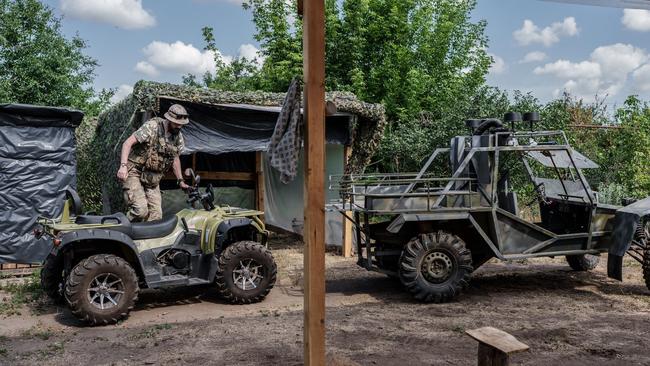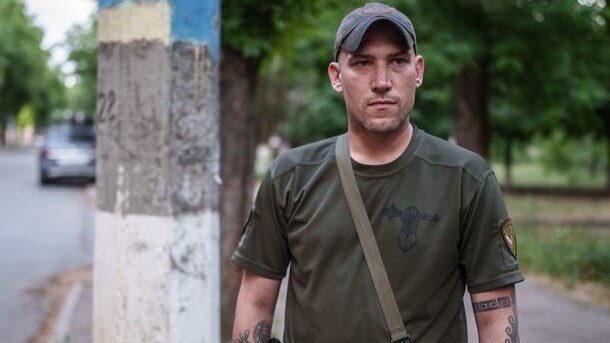Ukraine turns to beach buggies and e-bikes to evade drones
Smaller, quieter vehicles are harder to spot and hear, giving troops at the front line a better chance of survival.

The latest must-have on the battlefield in Ukraine is the kind of off-road buggy mostly used on farms or for beach racing.
The proliferation of surveillance and strike drones means that almost any movement near the frontline can be seen and targeted within minutes. To evade the threat, Ukraine and Russia are turning to a variety of small, quiet and manoeuvrable vehicles to deliver supplies, evacuate casualties and sometimes even send troops into battle.
Electric bicycles, buggies and all-terrain vehicles like quad bikes are harder to spot and hear than armoured vehicles, giving troops a better chance of survival.
One medic has even turned to an electric unicycle.
These smaller vehicles can’t fully cover the role of more conventional military vehicles. They lack firepower and the space to carry many people or supplies while the absence of armour leaves anyone on board dangerously exposed, but these alternative vehicles are carving out a niche that some frontline soldiers say has become essential.
“One hundred per cent they are useful,” said a commander of a frontline infantry unit whose call sign is Herring. “Because of the drones, often the hardest part of any mission is not the mission itself but the getting in and out,” said Herring, a US Army veteran, who is one of hundreds of foreigners fighting with Ukraine.
Armies have long used bikes and motorcycles in war, while US Special Forces deployed buggies and all-terrain vehicles to cross rough terrain in Iraq and Afghanistan. In Ukraine, the constant threat of drones has made the stealth-like qualities of smaller vehicles even more valuable.

On a recent night, Private Vitaly Shabliy loaded 350kg of ammunition and water on to the sort of buggy more commonly put to work on a farm. He turned off its lights and headed to a frontline trench 24km away.
The buggy, which is around 3m long by 1.5m high, was welded together in Kyiv and uses a Volkswagen engine. “The smaller it is the better it is in this war,” he said.
Shabliy’s brigade also has a Chinese-made ATV. Both vehicles are mainly used to move supplies, often with a trailer attached, but the buggy has also transported casualties.
“In reality, any man who has a driving licence can drive this,” said a sergeant whose call name is Nedok as he watched Shabliy manoeuvre his ATV into position.
By contrast, it takes at least three months to train for the role of driver mechanic for the brigade’s Soviet vintage BMP infantry fighting vehicles.
For soldiers from the Azov Brigade, fighting in the Kreminna forest in east Ukraine, smaller vehicles are essential for delivering supplies.
“We survive only because of them, because in a forest and those narrow paths, nothing else can get there,” said a local infantry commander whose call sign is Iraq.
Traditional trucks and wheeled vehicles can also struggle with the rugged, crater-pitted frontline.

One frontline medic, called Andriy, said he was constantly thinking about the quickest way to get to the wounded without being hit by enemy fire. He considered electric scooters, bikes and motorcycles but decided the manoeuvrability of an electric unicycle topped them all. “It allows you to move over any obstacles, such as sand or mud,” he said, adding that it could also accelerate up to 65km/h.
Electric bikes are also occasionally being used at the front for their stealth, and have the added benefit of generating less heat for radars and thermal vision to pick up, their manufacturers claim.
Ukrainian electric-bike manufacturer Eleek says it has delivered more than 100 bikes to the country’s military. The Atom model, which retails for about $US4850, can travel at more than 65km/h with a range of 100km, it says.
Ukrainian troops say they have seen a sharp uptick in Russians using similar, smaller vehicles.
Even Russian President Vladimir Putin is interested. Last November, he inspected Chinese-made Desertcross ATVs at a military headquarters in Russia, according to state news agency TASS. Russian forces already have 537 of the vehicles and have ordered some 1500 more, it said.
Oleksiy Yanyshpilsky, the commander and driver of a Ukrainian Bradley infantry fighting vehicle team called Wasabi, said since spring he had seen Russians on the east Ukraine frontline ride motorbikes to the relative protective cover of tree lines and assemble there before starting an assault.
There are drawbacks.
Travelling at high speed across pockmarked terrain makes them unstable while the lack of armoured protection leaves drivers and passengers vulnerable to enemy fire. “If you get hit near, nine times out of 10 you will catch shrapnel,” said Herring.
The vehicles can also struggle in bad weather, particularly mud, because their clearance from the ground is so low, Private Shabliy said.
Some Ukrainian units are far from convinced. One frontline brigade was recently given several quad bikes but says it can see little use for them, preferring more spacious trucks to deliver supplies.
The US and its allies have tested these modes of transport but are yet to fully embrace them.
The Wall Street Journal




To join the conversation, please log in. Don't have an account? Register
Join the conversation, you are commenting as Logout